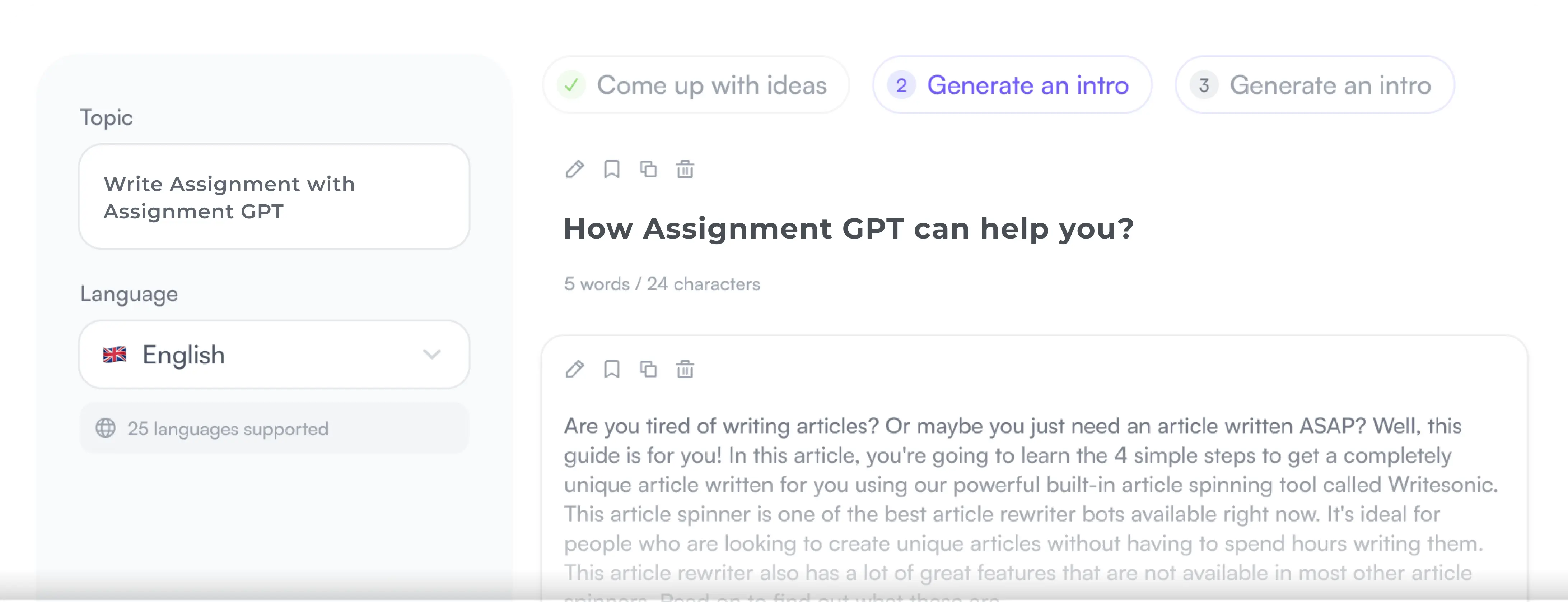AssignmentGPT Blogs
Sometimes, while writing on any important article or topic, you must have faced the confusion of how to start the topic. There is a lot of confusion in this because many thoughts come to your mind. It is not only you but everybody who faces this, so whether you are writing an academic paper or a blog post, business proposal, or a novel, without a clear direction you can never do professional writing, because without an outline, you will not get clarity about the path or goal of the subject.
Outlining is used to solve all these confusions because outlining works like a GPS and allows you to write every paragraph to headings in sequence, clarity and structure. Today, in this detailed article, we will learn about the six most common types of writing outlining, and we will also discuss the benefits of outlining and how to implement these strategies in your writing workflow effectively. Consider this article as your friendly mentor, which is going to help you improve your writing skills even more.
Quick Summary
Basically, there are a lot of benefits of outlining, as it helps you organize your thoughts and ideas before doing the final writing. Outlining is of many types, it has types in formal (structured) and informal (flexible) formats, and apart from this, there are a lot of types, in which six common types are most used in outlining, which are Alphanumeric, Decimal, Sentence, Topic, Working, and Reverse outlines.
And all these outlining is used for different purposes. By outlining, you can save a lot of your time and with this, you can improve the clarity of your writing a lot, and with this, the readability of your content also becomes of very high quality, and you can write all the headings and paragraphs to the point.
What is an Outline?
Outlining can be thought of as a planning tool for writing whose main intention is to organize any portion of writing so that you can produce high-quality writing. It is like the skeleton or blueprint of the writing, which decides the structure of the final piece of content. Just like proper mapping and planning of any building is done before its construction, outlining is used for the same purpose in professional writing too, to give solid support to your ideas and thoughts.
An outline is quite useful from rigid, hierarchical structures to flexible, free-form approaches. Choosing the right outlining is very important, and choosing any outlining also depends to a large extent on your content requirements and what style you are writing in, so that you can write according to your personal and professional preferences.
Formal vs. Informal Outlines
As we know, there are many types of outlining, and it largely depends on your content requirements, but as per industry standards, there are 2 main types of outlining: one is formal and the other is informal outlining. Let’s try to understand both in detail.
Formal Outlines: As the name suggests, it is related to professional writing, and this writing outlining is highly structured and uses hierarchical formats, for example, alphanumeric or decimal. Formal outlining is used for academic, business and research writing. And this outlining provides a complete roadmap for professional content so that your content follows the rules of industry standards. Formal outlining is used for content in which the tone of clarity, precision, and depth is important.
Informal Outlines: This type of outlining is mostly done for noting personal thoughts and ideas, so it is quite relaxed and more adaptable. Informal outlining also uses bullet points, mind maps, and question prompts. This writing style is perfect for creative writing.
Formal Outlines
Formal outlining helps you write your content in a structured order. Formal outlining is best for content where depth and precision are very important.
Characteristics: This writing style follows structured and hierarchical rules, and this outlining also follows alphanumeric or decimal format.
Ideal for: Formal outlining is especially considered perfect for research papers, academic essays and business proposals.
Informal Outlines
Informal outlining is used to note down your thoughts. Because this outlining format is very flexible, you can write according to your creativity.
Characteristics: Informal writing is quite flexible and free-form, and you can use it for bullet points, mind maps, or casual notes according to your needs.
Ideal for: You can use this writing style for your creative writing, scripts, or early crafts.
Types of Outlines in Writing
Let's discuss the 6 major types of outlining writing, with the best examples of all types and also about the scenarios used, so that you can get good information about all outlining.
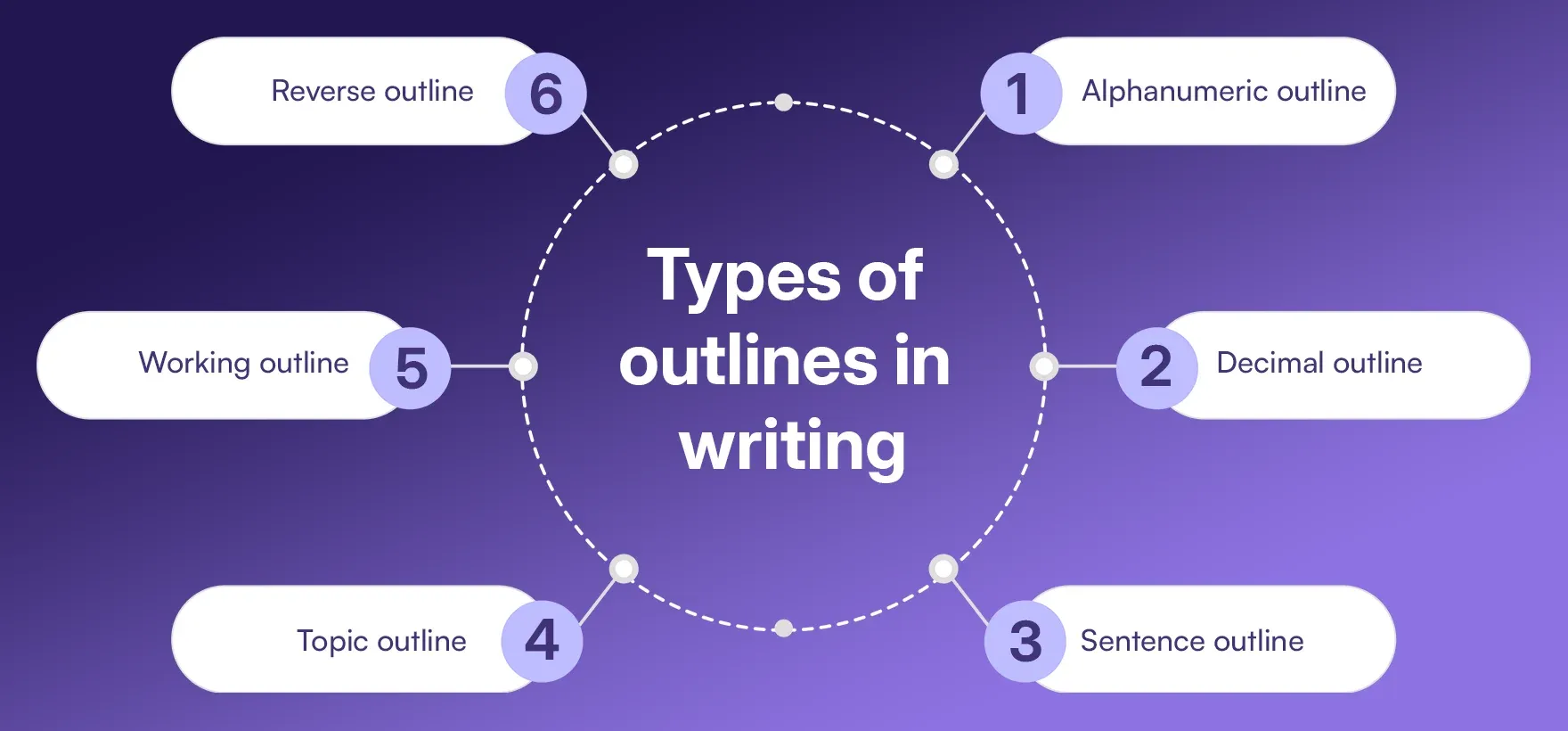
1. Alphanumeric Outline
Alphanumeric Outline is the most common form of outlining for research purposes, and it is also the most commonly used writing style. It involves a lot of process in which you write your writing in a specific order, and in it, roman numerals, letters, or Arabic numerals are used.
Format: In this, you can use Roman numerals, capital letters, Arabic numerals, and lowercase letters (I, A, 1, a) according to your content requirements.
Best For: It is used for content writing, essays, academic writing and research papers.
Example:
I. Introduction A. Background B. Thesis Statement II. Main Argument A. Supporting Point 1 1. Detail A 2. Detail B B. Supporting Point 2 III. Conclusion A. Restate Thesis B. Summary
2. Decimal Outline
This writing outline is used for technological purposes. Decimal outlining is used a lot for purposes like programming or coding.
Format: In this, numbers and decimals (1.0, 1.1, 1.1.1) format is used.
Best For: This is done for technical writing, manuals, reports and coding purposes.
Example:
1.0 Introduction 1.1 Purpose 1.2 Scope 2.0 Background 2.1 Historical Context 2.2 Current Issues 3.0 Solutions 3.1 Short-term 3.2 Long-term
3. Sentence Outline
Sentence outlining is used to summarize any large paragraph or idea. It helps in writing the in-depth part of any content in a shorter way.
Format: Its format is described in a full sentence.
Best For: Sentence outlining is used for speeches and detailed research planning.
Example:
I. Climate change is the most urgent environmental issue of our time. A. Rising global temperatures impact ecosystems globally. B. Human activities have accelerated climate change. II. Governments must take immediate action to reduce emissions.
Also read this article : Is Using AI Cheating
4. Topic Outline
Topic outlining tries to keep the idea or thoughts short, like short-tail keywords. Topic outlining is a structured list of a subject or theme using words and phrases to organize any idea or information.
Format: Short phrases or single words are commonly used in topic outlining.
Best For: It is used for quick planning and noting down creative ideas.
Example:
I. Benefits of Exercise A. Physical health B. Mental well-being II. Types of Exercise A. Cardio B. Strength training
5. Working Outline
A working outline is like a rough sketch in which you can note down your ideas and thoughts in a flexible way, and it is best for noting down messy ideas and thoughts.
Format: You can keep it flexible and informal, as there is no rigidity in the working outline.
Best For: You can prefer this for evolving projects and long-form writing.
Example:
Topic: Future of AI in Education What AI tools are currently used? Benefits of AI for teachers and students Ethical concerns and limitations
6. Reverse Outline
This is a method in which the writer tries to reverse outline any already written content or draft, so that they can get an idea of which ideas or thoughts were behind writing it. It is mostly used to decode the ideas of the content. This also helps them to know what other improvements can be made to it.
Format: This summarizes and outlines each paragraph after drafting or from published content.
Best For: Reverse outlining is used for revising drafts, improving clarity and decoding content ideas.
Example:
Paragraph 1: Introduces the topic but lacks a thesis → Add a thesis. Paragraph 2: Provides a strong argument but no evidence → Insert data. Paragraph 3: Good conclusion → No changes needed.
Benefits of Outlining
Outlining is the most important part of professional writing, because it makes it possible to achieve the goal of the content also by saving a lot of time. Apart from this, it also has many other benefits. Let's discuss those benefits.
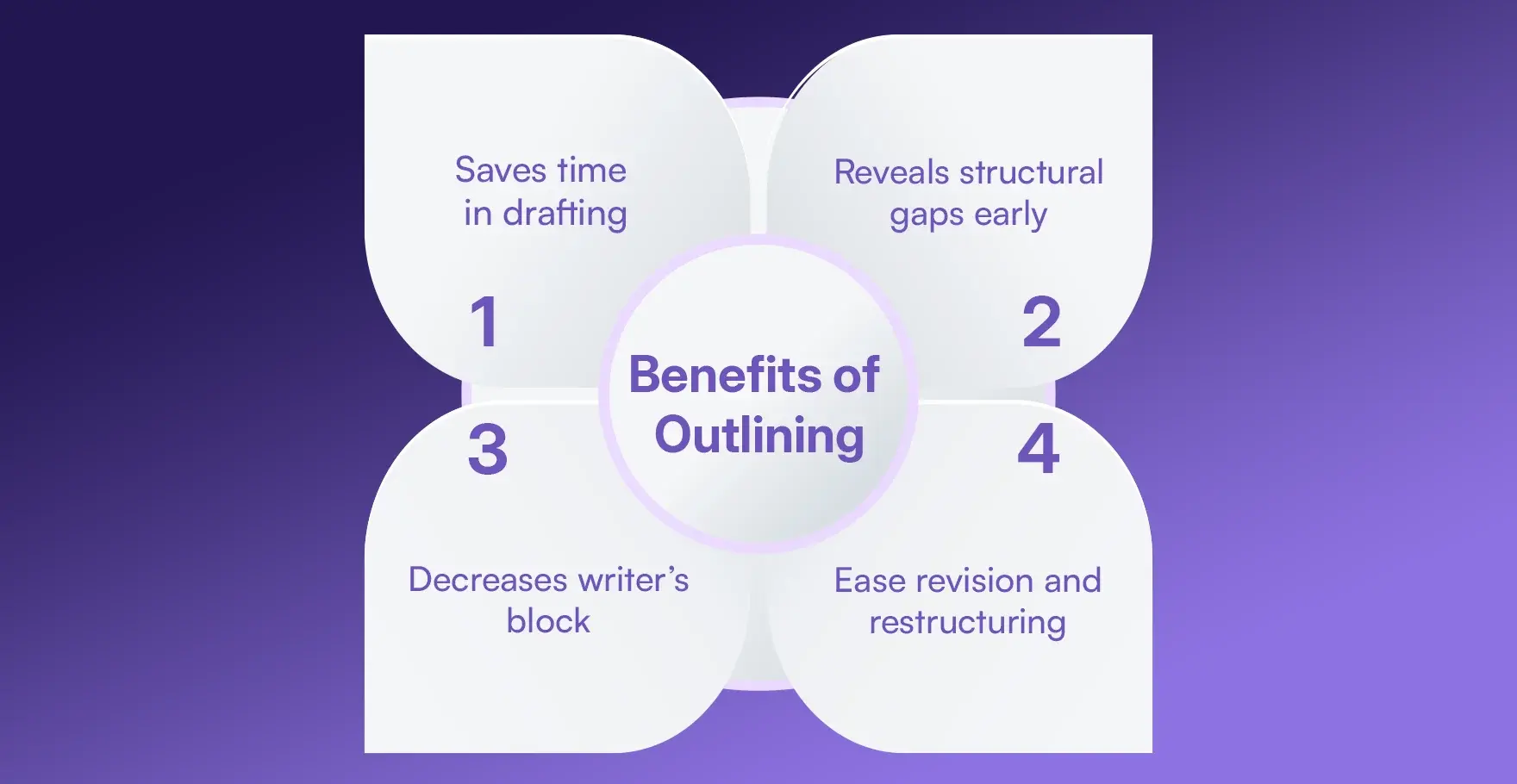
Saves Time: As we know that outlining saves a lot of your time, because you do not have to think about ideas again and again while writing, because you already have a sequence format available.
Reveals Gaps: You can find out the problems in your outline writing before your writing becomes problematic or of low quality.
Reduces Writer’s Block: This gives you an idea of what you have to write next. You don’t have to think again and again about the next heading and what will be its writing material.
Improves Structure: By outlining, you remain focused on your topic and your complete writing is on-topic, due to which your readers also get high-quality information.
Streamlines Revisions: When you write without an outline and if you have to make changes after writing, it takes a lot of time and the flow of the content gets spoiled, but by outlining, you fix all the problems in your outlining process itself, so that the flow of your final content is smooth and all the lines feel connected to each other.
Choosing the Right Outline
There is no fixed format or process to choose the right outlining. It largely depends on your experience and the demand for your content, that's why mostly professionals use outlining.
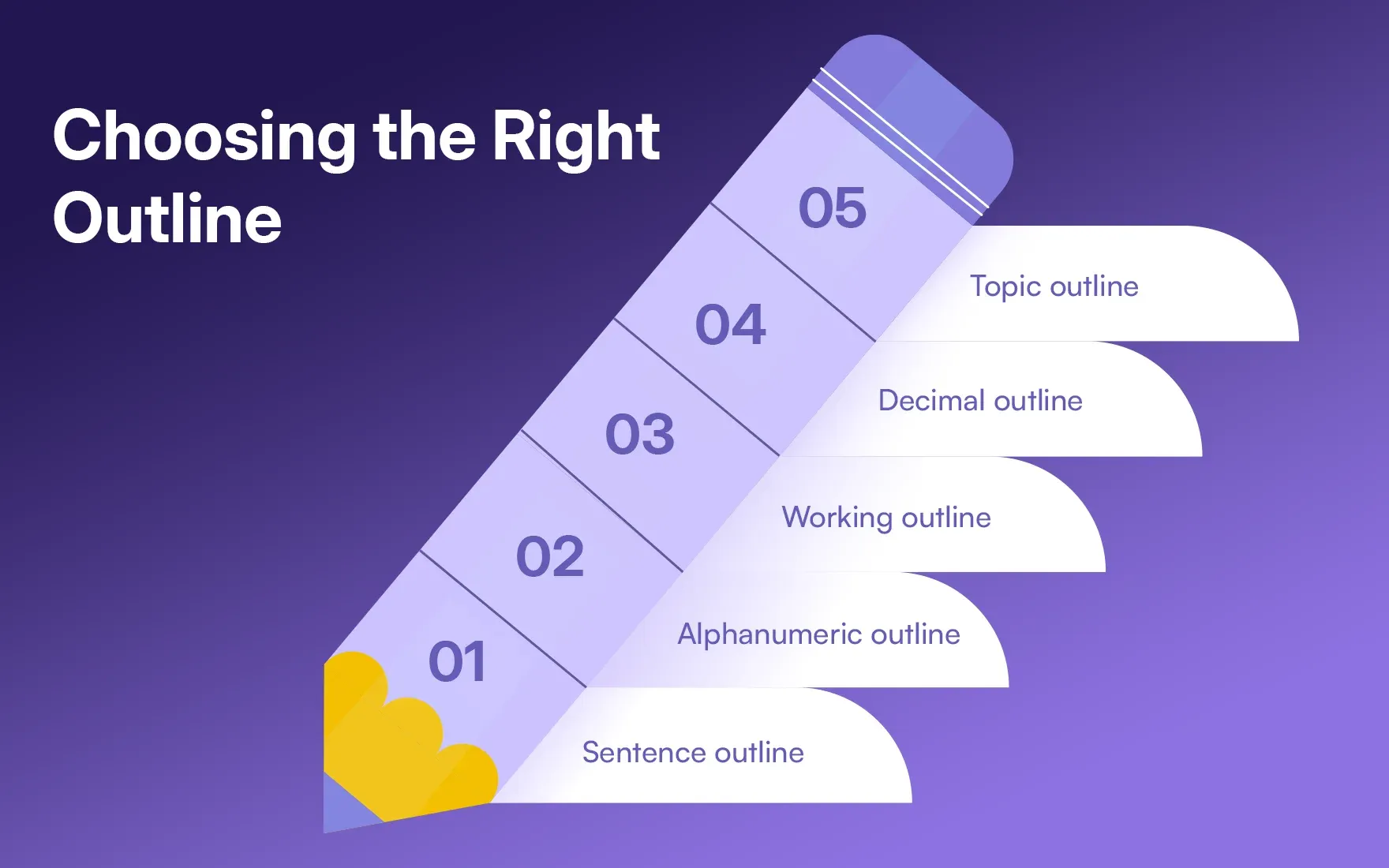
1. Alphanumeric: When you need structure in your content, you should follow alphanumeric outlining.
2. Decimal: For precise, technical docs, you can use decimal outlining.
3. Sentence: When you want clarity from the start to the end of your content, then you can choose sentence outlining.
4. Topic: Use this outline when you need to generate an idea quickly.
5. Working: If you need to roughly note down your idea, then use this outlining style.
6. Reverse: You can use reverse outlining when you need to make revisions to existing drafts or decode newly published content.
Read More : 7 Best stress management techniques for students
How to Implement Outlines in Your Workflow
Let's understand with some practical tips how you can finally use outlining in your workflow.
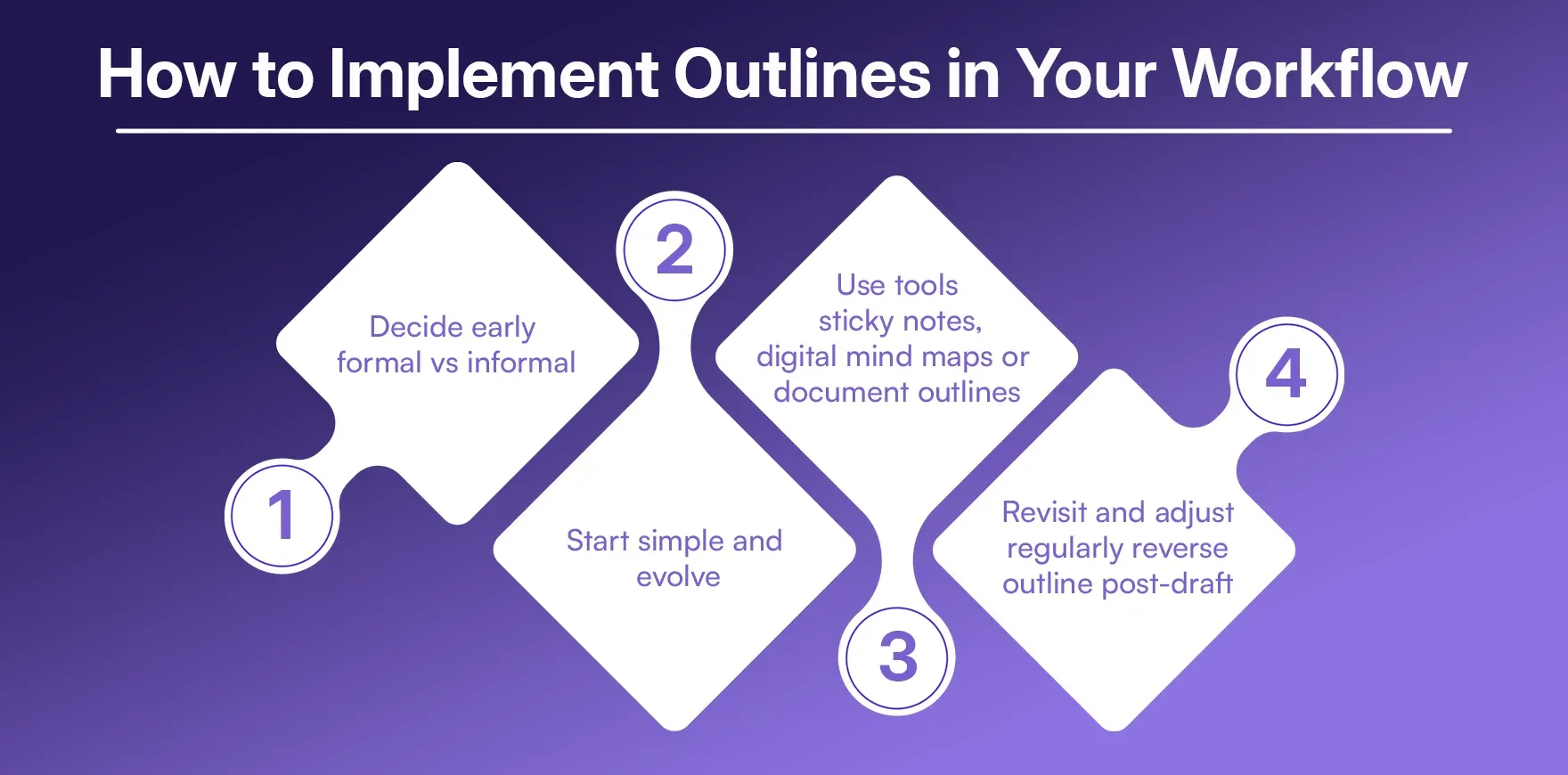
Decide Early: You should decide first whether your content is going to be formal or informal, because for outlining, it is very important to decide this.
Start Simple: You try to start with a rough sketch and then you can refine it.
Use Tools: For outlining, it is very important that you use tools like Notion, Google Docs, or a mind map.
Review & Revise: Whenever you feel your draft or outline does not sound professional, use reverse outlining in your draft or of similar topic content, so that you can polish your idea further.
Conclusion
Outlining is not only used for school essays or research papers, but is valid for all types of writing. They are essential tools that can revolutionize the way you write. Whether you want to do structured writing or just note down your thoughts, you can use outline for everything. Once you find the rhythm of your content, outlining becomes quite easy, and it also keeps your creativity professionally on point.
FAQs
1. What are the four main components of an outline?
2. What is the most common type of outline?
3. What’s the difference between formal and informal outlines?
4. Which type of outline includes the most detail?
5. Can I switch outlines midway?
Content writer at @AssignmentGPT
Ashu Singh, content writer at AssignmentGPT, crafting clear, engaging content that simplifies complex tech topics, with a focus on AI tools and digital platforms for empowered user experiences.
Master AI with
AssignmentGPT!
Get exclusive access to insider AI stories, tips and tricks. Sign up to the newsletter and be in the know!
Transform Your Studies with the Power of AssignmentGPT
Empower your academic pursuits with tools to enhance your learning speed and optimize your productivity, enabling you to excel in your studies with greater ease.
Start Your Free Trial ➤Start your success story with Assignment GPT! 🌟 Let's soar! 🚀
Step into the future of writing with our AI-powered platform. Start your free trial today and revolutionize your productivity, saving over 20 hours weekly.
Try For FREE ➤